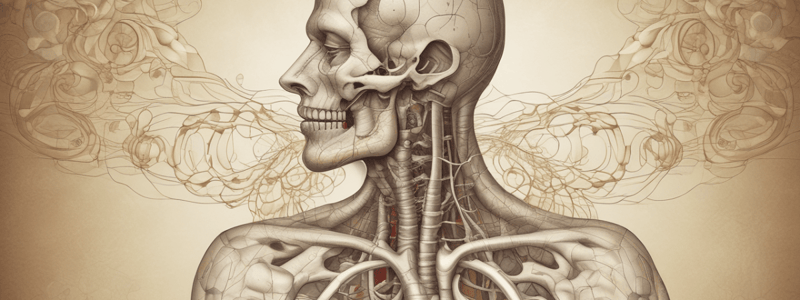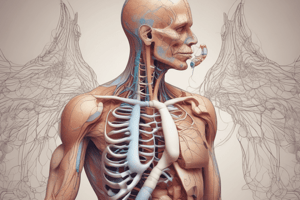Podcast
Questions and Answers
What is the term for the exchange of oxygen and carbon dioxide between the lungs and bloodstream?
What is the term for the exchange of oxygen and carbon dioxide between the lungs and bloodstream?
- Respiration
- Regulation
- Gas Exchange (correct)
- Breathing
What is the primary function of the respiratory system?
What is the primary function of the respiratory system?
- To circulate blood throughout the body
- To facilitate digestion
- To bring oxygen into the body and remove carbon dioxide (correct)
- To regulate body temperature
Which muscle is responsible for facilitating breathing?
Which muscle is responsible for facilitating breathing?
- Diaphragm (correct)
- Intercostal muscles
- Smooth muscles
- Skeletal muscles
What is the term for the amount of air inhaled or exhaled with each breath?
What is the term for the amount of air inhaled or exhaled with each breath?
Which part of the respiratory system is responsible for containing vocal cords?
Which part of the respiratory system is responsible for containing vocal cords?
What occurs during inhalation?
What occurs during inhalation?
What is the term for the additional air that can be inhaled?
What is the term for the additional air that can be inhaled?
What is the purpose of the trachea?
What is the purpose of the trachea?
What is the term for the process of breathing in and out?
What is the term for the process of breathing in and out?
What is the site of gas exchange in the lungs?
What is the site of gas exchange in the lungs?
Which part of the brain helps regulate breathing rate?
Which part of the brain helps regulate breathing rate?
What is the purpose of chemoreceptors in the respiratory system?
What is the purpose of chemoreceptors in the respiratory system?
Which of the following is NOT a function of the respiratory system?
Which of the following is NOT a function of the respiratory system?
What is the term for the air passages that divide into smaller bronchioles?
What is the term for the air passages that divide into smaller bronchioles?
Which of the following is a disorder of the respiratory system?
Which of the following is a disorder of the respiratory system?
What is the function of the diaphragm during exhalation?
What is the function of the diaphragm during exhalation?
Which part of the brain regulates breathing rate and depth?
Which part of the brain regulates breathing rate and depth?
What is the site where oxygen diffuses into the blood?
What is the site where oxygen diffuses into the blood?
What is the primary function of gas exchange in the lungs?
What is the primary function of gas exchange in the lungs?
During which step of gas exchange does oxygen bind to hemoglobin in red blood cells?
During which step of gas exchange does oxygen bind to hemoglobin in red blood cells?
In which direction does carbon dioxide diffuse during gas exchange?
In which direction does carbon dioxide diffuse during gas exchange?
What is the result of oxygen diffusing from the capillaries into the tissues?
What is the result of oxygen diffusing from the capillaries into the tissues?
What is the function of oxyhemoglobin formed during gas exchange?
What is the function of oxyhemoglobin formed during gas exchange?
What is the final step of gas exchange in the lungs?
What is the final step of gas exchange in the lungs?
Study Notes
Overview
- The respiratory system is responsible for bringing oxygen into the body and removing carbon dioxide.
- It includes the nose, mouth, throat, lungs, and trachea.
Functions
- Gas Exchange: exchanging oxygen and carbon dioxide between the lungs and bloodstream.
- Respiration: breathing in and out, facilitated by the diaphragm and intercostal muscles.
- Regulation: controlling the rate and depth of breathing, influenced by the brain and nervous system.
Components
- Upper Respiratory Tract:
- Nose and mouth: entrance points for air.
- Pharynx (throat): common passage for air and food.
- Larynx (voice box): contains vocal cords.
- Lower Respiratory Tract:
- Trachea (windpipe): divides into bronchi.
- Bronchi: branch into bronchioles.
- Bronchioles: lead to alveoli.
- Alveoli: tiny sacs where gas exchange occurs.
- Lungs: organs responsible for gas exchange.
- Diaphragm: primary muscle for breathing, separates chest and abdominal cavities.
Processes
- Inhalation:
- Diaphragm contracts and flattens.
- Intercostal muscles contract, expanding the chest cavity.
- Air enters the lungs through the nose or mouth.
- Exhalation:
- Diaphragm relaxes and rises.
- Intercostal muscles relax, reducing the chest cavity.
- Air leaves the lungs through the nose or mouth.
Respiratory Volumes
- Tidal Volume (TV): amount of air inhaled or exhaled with each breath.
- Inspiratory Reserve Volume (IRV): additional air that can be inhaled.
- Expiratory Reserve Volume (ERV): additional air that can be exhaled.
- Residual Volume (RV): air remaining in the lungs after exhalation.
Respiratory Rate
- Normal Respiratory Rate: 12-20 breaths per minute.
- Factors Affecting Respiratory Rate: exercise, emotions, temperature, and altitude.
Overview
- The respiratory system brings oxygen into the body and removes carbon dioxide, involving organs such as the nose, mouth, throat, lungs, and trachea.
Functions
- Gas exchange: the lungs exchange oxygen and carbon dioxide with the bloodstream.
- Respiration: the process of breathing in and out, facilitated by the diaphragm and intercostal muscles.
- Regulation: the brain and nervous system control the rate and depth of breathing.
Components
- Upper Respiratory Tract:
- Nose and mouth: air entrance points.
- Pharynx (throat): common passage for air and food.
- Larynx (voice box): contains vocal cords.
- Lower Respiratory Tract:
- Trachea (windpipe): divides into bronchi.
- Bronchi: branch into bronchioles.
- Bronchioles: lead to alveoli.
- Alveoli: tiny sacs where gas exchange occurs.
- Lungs: organs responsible for gas exchange.
- Diaphragm: primary muscle for breathing, separates chest and abdominal cavities.
Processes
- Inhalation:
- Diaphragm contracts and flattens.
- Intercostal muscles contract, expanding the chest cavity.
- Air enters the lungs through the nose or mouth.
- Exhalation:
- Diaphragm relaxes and rises.
- Intercostal muscles relax, reducing the chest cavity.
- Air leaves the lungs through the nose or mouth.
Respiratory Volumes
- Tidal Volume (TV): amount of air inhaled or exhaled with each breath.
- Inspiratory Reserve Volume (IRV): additional air that can be inhaled.
- Expiratory Reserve Volume (ERV): additional air that can be exhaled.
- Residual Volume (RV): air remaining in the lungs after exhalation.
Respiratory Rate
- Normal Respiratory Rate: 12-20 breaths per minute.
- Factors Affecting Respiratory Rate: exercise, emotions, temperature, and altitude.
Respiratory System
- Brings oxygen into the body and removes carbon dioxide, essential for the survival of all living organisms
Functions
- Regulates oxygen intake and carbon dioxide removal
- Maintains pH levels in the body
Organs Involved
- Nose: air entrance
- Mouth: alternative air entrance
- Throat (pharynx): air passage
- Larynx (voice box): air passage
- Trachea (windpipe): air passage
- Bronchi: air passage, divides into smaller bronchioles
- Lungs: site of gas exchange
- Diaphragm: muscle involved in inhalation and exhalation
- Intercostal muscles: muscles involved in inhalation and exhalation
Process of Respiration
- Inhalation: air enters nostrils or mouth, passes through throat, larynx, trachea, bronchi, and bronchioles, and reaches alveoli
- Gas Exchange: oxygen diffuses into blood, carbon dioxide diffuses out of blood
- Exhalation: diaphragm and intercostal muscles relax, air is pushed out of lungs, and passes through the same pathway as inhalation
Breathing Control
- Brainstem: regulates breathing rate and depth
- Pons: helps regulate breathing rate
- Medulla oblongata: helps regulate breathing rate
- Chemoreceptors: detect changes in CO2 levels and pH
Disorders and Diseases
- Asthma: respiratory disorder characterized by inflammation and narrowing of airways
- Chronic obstructive pulmonary disease (COPD): progressive lung disease that makes it difficult to breathe
- Pneumonia: infection of the lungs that can cause inflammation and damage
- Lung cancer: malignant growth of lung cells
- Emphysema: lung disease that damages air sacs, causing difficulty breathing
Gas Exchange at Lungs
- Gas exchange occurs between the lungs and bloodstream, allowing oxygen to enter the body and carbon dioxide to be removed
- The process involves the exchange of gases between the alveoli, air sacs in the lungs, and the capillaries, tiny blood vessels surrounding the alveoli
Steps of Gas Exchange
- Air enters the lungs through inhalation, bringing oxygen into the alveoli during inspiration
- Oxygen diffuses from the alveoli into the capillaries, where it binds to hemoglobin in red blood cells
- Oxygen binds to hemoglobin, forming oxyhemoglobin (HbO2)
- Oxyhemoglobin is transported to the body's tissues through the bloodstream
- Oxygen diffuses from the capillaries into the tissues, where it is used for cellular respiration
- Carbon dioxide, a waste product, diffuses from the tissues into the capillaries
- Carbon dioxide is transported back to the lungs through the bloodstream
- Carbon dioxide is exhaled out of the lungs through exhalation
Factors Affecting Gas Exchange
Physical Factors
- The large surface area of the alveoli and capillaries allows for efficient gas exchange
- The short distance between the alveoli and capillaries allows for rapid diffusion
Pressure and Flow
- The partial pressure of oxygen and carbon dioxide in the alveoli and capillaries drives diffusion
- The balance between ventilation (airflow) and perfusion (blood flow) is critical for efficient gas exchange
Studying That Suits You
Use AI to generate personalized quizzes and flashcards to suit your learning preferences.
Description
Explore the functions and components of the respiratory system, including gas exchange, respiration, and regulation. Learn about the different parts involved, such as the nose, mouth, throat, lungs, and trachea.




